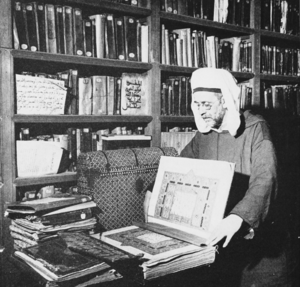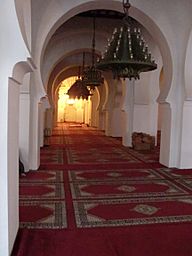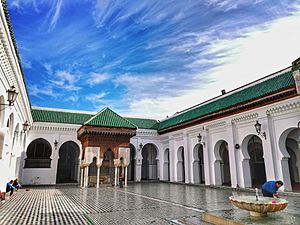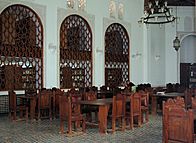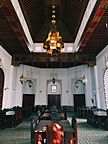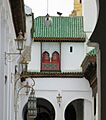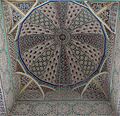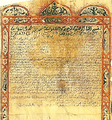University of al-Qarawiyyin facts for kids
|
جامعة القرويين
ⵜⴰⵙⴷⴰⵡⵉⵜ ⵏ ⵍⵇⴰⵕⴰⵡⵉⵢⵉⵏ |
|
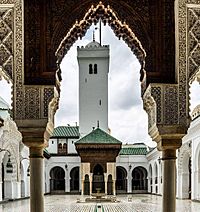
Courtyard of the mosque and its minaret
|
|
| Type | Madrasa and center of higher learning for non-vocational sciences (before 1963) State university since 1963 |
|---|---|
| Established | 857–859 (as a mosque), 1963 (as a state university) |
|
Academic staff
|
1,025 (2012) |
|
Administrative staff
|
708 (2012) |
| Students | 8,120 (2012) |
| Location | , |
| Campus | Urban |
| Language | Arabic, Tamazight, French |
| Founder | Fatima al-Fihri |
| Colours | White |
 |
|
The University of al-Qarawiyyin is a famous university in Fez, Morocco. It started as a mosque built by Fatima al-Fihri between 857 and 859 CE. Over time, it grew into a major center for learning and religion during the Islamic Golden Age.
In 1963, it officially became part of Morocco's modern university system. Two years later, it was renamed "University of Al Quaraouiyine." The mosque building itself is also a beautiful example of old Moroccan and Islamic architecture. It shows styles from many different times in Moroccan history.
Some groups, like UNESCO and the Guinness World Records, say al-Qarawiyyin is the oldest university in the world. Or, at least, the oldest place for higher learning that has been open continuously. Before 1963, it worked more like a madrasa, which is a type of Islamic school.
Today, the university mainly teaches Islamic religious and legal studies. It is especially strong in Classical Arabic and Maliki Sharia (Islamic law). However, students can also learn other subjects. Students come from all over Morocco and West Africa. Women were first allowed to study here in the 1940s.
What's in a Name?
The university's Arabic name, جَامِعَةُ الْقَرَوِيِّينَ, means "University of the People from Kairouan". Kairouan is a city in Tunisia.
The founder, Fatima al-Fihri, came from Kairouan. Because of this, the mosque and university were named after her family's origin. You might see the name spelled in different ways, like al-Qarawiyyin, Al Quaraouiyine, or Al-Karaouine. This is because the Arabic sounds are hard to write perfectly in other languages.
A Look at Its History

How the Mosque Began
In the 800s, Fez was the capital of the Idrisid dynasty. This was Morocco's first Islamic state. A story says that Fatima al-Fihri, a rich merchant's daughter, founded the mosque in 857 or 859 CE. Her family had moved from Kairouan, Tunisia, to Fez. Fatima and her sister Mariam inherited a lot of money. Fatima decided to use all her inheritance to build a mosque for her community. Mariam is also said to have founded the Mosque of the Andalusians around the same time.
Some historians wonder if this story is completely true. They think it might be a legend because two sisters founding two famous mosques at the same time seems too perfect. An old inscription found in the mosque suggests it might have been founded by Dawud ibn Idris in 877 CE. However, the story of Fatima al-Fihri is still widely told.
Early Years of Learning
Teaching probably started at al-Qarawiyyin Mosque very early on. In the early Islamic period, large mosques were often places for both worship and education. It's not clear exactly when al-Qarawiyyin became a formal school. Some historians believe it started teaching during the Almoravids' rule (1040–1147). Others suggest it was later, during the Marinid period (1244–1465).
By the 900s, the Qarawiyyin Mosque became very important. It became the main mosque for Friday prayers in Fez. This showed its high status. Rulers from different dynasties continued to expand and decorate the mosque. All other mosques in Fez even set their prayer times based on al-Qarawiyyin's call to prayer.
Golden Age: Marinid Period
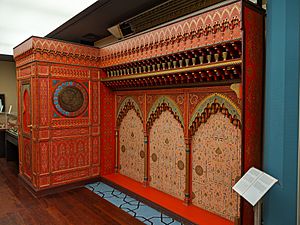
Many scholars agree that al-Qarawiyyin was at its best as a learning center in the 1200s and 1300s. During this time, it taught many subjects. These included religious studies like the Quran and Islamic law (fiqh). It also taught grammar, rhetoric, logic, medicine, mathematics, astronomy, and geography.
The Marinid rulers built many schools called madrasas around the mosque. These madrasas, like the Al-Attarine Madrasa (built in 1323), offered their own courses. But their main job was to provide housing for students who came from other towns to study at al-Qarawiyyin. So, these buildings helped al-Qarawiyyin, which stayed the main place for learning.
Al-Qarawiyyin also had a huge library. It was founded by Sultan Abu Inan Faris in 1349. The library held many old books from different regions. Some very special books are still there today. These include a 9th-century Quran written on gazelle parchment. Also, there's a copy of Ibn Khaldun's famous book Al-'Ibar, given by the author in 1396.
Students were usually male. But it's said that women could listen to lessons from a special gallery. Famous scholars like Ibn Khaldun and Leo Africanus were connected to al-Qarawiyyin as students or teachers.
Changes and Modernization
Over later centuries, al-Qarawiyyin's teaching became less varied. It focused mostly on traditional Islamic studies. Some subjects like astronomy and medicine were no longer taught. In the 1700s and 1800s, rulers tried to reform the school. But these changes didn't always last. By the early 1900s, the number of teachers and students had decreased.
When Morocco became a French protectorate in 1912, al-Qarawiyyin's importance as a religious learning center continued to decline. The French tried to make some changes to how the school was run. However, they didn't update the subjects taught. Many Moroccan leaders who fought for independence had studied at al-Qarawiyyin. The mosque was also a place for protests against French rule.
In 1947, al-Qarawiyyin became part of the state education system. Women were allowed to study there in the 1940s. In 1963, after Morocco became independent, it was officially made a university by the king. The old classes in the mosque stopped. New campuses were built, and modern subjects and textbooks were introduced.
What Students Learn Today
Today, al-Qarawiyyin University focuses on Islamic religious and legal studies. It teaches Classical Arabic grammar and Maliki law very well. Students also learn some non-Islamic subjects like French and English.
Teachers sit in front of students, who are in a semi-circle. The teacher asks students to read texts, asks questions, and explains difficult parts. Most students are between 13 and 30 years old. They work towards high school and university degrees. To get in, students must have memorized the entire Quran. They also need to know other Islamic texts and be good at classical Arabic.
The Mosque's Amazing Architecture
The Al-Qarawiyyin Mosque was built in the 800s. But its current look comes from over 1,000 years of changes. It grew to be the largest mosque in Africa, holding 22,000 worshipers. The mosque covers about half a hectare (about 1.2 acres). It has a large prayer hall, a courtyard with fountains, a minaret, and other buildings around it.
How the Mosque Grew Over Time
The first mosque was built in the 9th century. It was a rectangular prayer hall with four aisles. It also had a small courtyard and a minaret. As Fez grew, the mosque needed to be bigger. In 956, it was expanded on three sides. The original minaret was replaced with the larger one you see today.
In the 1100s, under the Almoravid ruler Ali ibn Yusuf, the prayer hall was made even bigger. Three more aisles were added, making a total of ten. This expansion also added beautiful decorations. These included detailed dome ceilings with muqarnas (honeycomb-like carvings). A new minbar (pulpit) was also installed in 1144. It was made of wood with amazing patterns.
Later rulers, like the Almohads (1100s-1200s), added more features. They improved the ablutions (washing) facilities. They also added a huge bronze chandelier. It was so big it could hold 520 oil candles!
The Marinid dynasty (1200s-1300s) also made many contributions. In 1286, they fixed the 10th-century minaret. They also built the Dar al-Muwaqqit, a room for the mosque's timekeeper. This room had astrolabes and water clocks to help tell the exact prayer times. The mosque's library was officially started by Sultan Abu Inan in 1349.
The Saadians (1500s-1600s) added two beautiful pavilions to the courtyard. Each pavilion had a fountain. These pavilions look like the ones in the Alhambra palace in Spain. The Alaouite dynasty (since the 1600s) has continued to maintain and add small details to the mosque.
What You See Today
Outside the Mosque
The outside of al-Qarawiyyin doesn't look grand from far away. It blends in with the busy city around it. There are 18 different gates and entrances. Some gates have beautiful bronze decorations from the Almoravid period. One gate, Bab al-Hafa, has a small water channel inside. This allowed worshipers to wash their feet as they entered.
Next to the mosque is a tower called the Borj Neffara. People sometimes confuse it with a minaret. But it was actually part of another timekeeping building.
Inside the Prayer Hall
The large prayer hall is most of the mosque. It has plain walls, wooden roofs, and many rows of arches. The main area has ten aisles. The southern wall is the qibla, which shows the direction of prayer towards Mecca. A central path leads to the mihrab, a special niche in the qibla wall where the imam leads prayers.
The mihrab is from the 12th-century Almoravid expansion. It has carved stucco and colored glass windows. The central path is special. It has different shaped arches and beautiful muqarnas ceilings. These ceilings are carved with intricate designs and Arabic writing. Several large bronze chandeliers hang here. Some were made from church bells brought from Spain!
To the right of the mihrab is the minbar, a finely carved wooden pulpit. It was made in 1144 and is a masterpiece of woodcarving.
The Courtyard (Sahn)
The sahn (courtyard) is rectangular. It has a fountain in the middle and is paved with colorful Moroccan mosaic tiles (zellij). The main northern gate, Bab al-Ward, opens into the courtyard. Opposite this gate is the entrance to the prayer hall. This entrance has a carved wooden screen called the anaza. It also served as a symbolic outdoor mihrab for prayers in the courtyard.
At the ends of the courtyard are two beautiful Saadian pavilions. Each has a fountain and a pyramid-shaped roof. They are decorated with carved wood, stucco, and mosaic tiles. The area on the northeastern side of the courtyard is a prayer space for women.
The Minaret
The minaret was built in the 900s. It stands on the west side of the courtyard. It is one of the oldest minarets in Morocco. It has a square shape and is topped with a dome. It is about 26.75 meters (87 feet) tall. A unique feature is a triple horseshoe arch window on its southern side.
The Library
Behind the southern wall of the mosque is the historic library. Some people say it's the oldest library in the world that is still open. The first library building was added in 1349 by Sultan Abu Inan Faris.
The current library building was mostly expanded in the 1940s by King Mohammed V. It includes a large reading room with a beautifully painted wooden ceiling. A new entrance was added so non-Muslims could visit. The library was recently restored and reopened.
Is it the Oldest University?
Some sources, like UNESCO and Guinness World Records, call al-Qarawiyyin the "oldest university in the world." They compare it to the University of Bologna in Europe, which started in 1088.
However, many scholars believe the term "university" really applies to schools that first appeared in medieval Christian Europe. They argue that the modern idea of a university comes from this European tradition. They see al-Qarawiyyin as working more like an Islamic school (madrasa) until it was officially changed into a university in 1963.
There is a debate about whether medieval Islamic schools influenced European universities. Some scholars see similarities. Others point out differences in how they were set up and taught. The exact date when formal teaching began at al-Qarawiyyin is also not fully clear from old records.
Famous People Who Studied Here
Many important thinkers, scholars, and leaders have studied or taught at al-Qarawiyyin. Here are a few:
- Maimonides (1135/1138–1204), a Jewish philosopher.
- Ibn Arabi (1165–1240), a Sufi philosopher.
- Ibn Khaldun (1332–1406), a famous historian and philosopher.
- Leo Africanus (1494–1554), a well-known author.
- Abd el-Krim el-Khattabi (1882–1963), a Moroccan political and military leader.
- Allal al-Fassi (1910–1974), a Moroccan politician.
- Fatima al-Kabbaj (1932–), one of the first women admitted to the university.
Images for kids
 In Spanish: Universidad de Qarawiyyin para niños
In Spanish: Universidad de Qarawiyyin para niños


